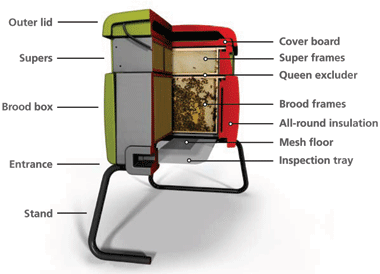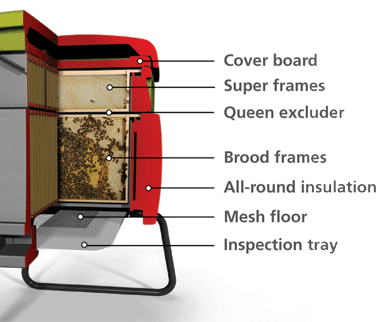What are the main parts of a beehive called?
The diagram below shows a Beehaus with a section removed so that you can see the inside as well as the outside. From the outside you can see the main parts of a beehive are the lid, the supers, the brood box, the entrance and the stand. These are each described in more detail below.

Outer lid - This protects the hive from the cold, wind and rain. It provides year round insulation.
Supers - The supers are used by the bees to store honey. A colony will store honey throughout the summer in preparation for the winter. If your bees are successful they will have surplus honey which you can harvest for your own use.
Brood box - This is the colony's home, the place where the bees live and where the queen lays her eggs. These large frames are referred to as brood frames. When inspecting your hive these are the frames that you look through. Your beehaus comes with 11 brood frames with wax foundation sheets.
Entrance - Every hive must have an entrance to allow the bees to come and go. The entrance is sheltered from the wind and rain. It leads to an inner hive entrance which is large enough for the bees to bring in nectar and pollen - but small enough to defend easily.
Stand - A good hive stand should bring the working height of the hive up to waist height to reduce the effort of handling the parts of the hive. It will also keep the hive out of cold pockets of air in the winter. The Beehaus comes with sturdy legs that raise the top of the hive to 0.8m.
What are the parts inside a beehive called?The inside of a Beehaus is shown below and the labeled parts are also described in more detail.

Cover board - The cover board is used to seal the bees inside the hive. In the winter, when there are no supers on the beehive, the cover board sits on the brood box. In summer, when the supers are on, the cover board sits on top of the super. The beehaus comes with four cover boards - one for each super.
Super frames - The super frames are shallower than the brood frames. They hold the wax foundation that the bees build the comb on.
Queen excluder - The supers are just for storing honey but the queen doesn't know this and will sometimes lay eggs in them. This makes harvesting the honey difficult so a special sheet called a 'queen excluder' is placed directly on top of the brood frames. The queen excluder has holes big enough for the workers to get through but too small for the queen and therefore prevents the queen from climbing up into the supers. The beehaus comes with four queen excluders, one for each super.
Brood frames - The brood frames are where the bees store nectar and pollen for their immediate use. It's also where the queen lays the eggs that will hatch first into larvae and then metamorphose into new bees. There are lots of slightly different sizes of frames. The Beehaus uses deep National frames which are the most common size used in the UK.
Insulation - Bees need to maintain a constant temperature to raise their young. The better insulated a hive, the less energy the bees will have to expend on maintaining this temperature. The Beehaus has all round triple pocket insulation that greatly reduces the heat loss from the hive in winter and helps the bees keep the hive cool in the summer.
Mesh floor - Some beehives have a solid floor but the best type of floor for a beehive is made of mesh. This provides all-year round draught free ventilation in the hive. Good air circulation is important for healthy bees. The mesh floor also allows debris to fall out of the hive, saving the bees the effort of having to remove this themselves. The Beehaus has a full length mesh floor.
Inspection tray - To make full use of the mesh floor, the best beehives have an inspection tray underneath. The inspection tray catches any mites or debris that fall from the hive which you can then examine to learn about the health of your bees. The Beehaus comes with an inspection tray as standard.
Comments
There are no comments just yet